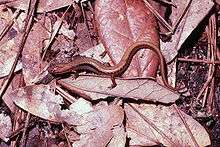Dwarf salamander
The dwarf salamander (Eurycea quadridigitata) is a species of salamander native to the southern United States, from North Carolina to Oklahoma, south to Texas along the Gulf of Mexico states to northern Florida. Some sources refer to it as the four-fingered manculus, dwarf four-toed salamander, or the Florida dwarf salamander.
| Dwarf salamander | |
|---|---|
 | |
| Scientific classification | |
| Kingdom: | Animalia |
| Phylum: | Chordata |
| Class: | Amphibia |
| Order: | Urodela |
| Family: | Plethodontidae |
| Genus: | Eurycea |
| Species: | E. quadridigitata |
| Binomial name | |
| Eurycea quadridigitata (Holbrook, 1842) | |
| Synonyms | |
Description
The dwarf salamander grows from 2.0 to 3.5 inches in length. It has a slender body and a long tail. It is typically yellow-brown in color with darker brown blotching and dark stripes down each side, but the pattern and coloration can vary widely. The epithet quadridigitatat is to denote that each of its feet has four toes.
Behavior
The dwarf salamander prefers habitats of swampy pine woods. It is nocturnal and spends most of its time under leaf litter or forest floor debris. Breeding occurs in the fall, with 12 to 48 eggs being laid singly or in small clutches attached to submerged debris in shallow, slow moving or still water.
References
- Amphibian Species of the World: Eurycea quadridigitata
- Herps of Texas: Eurycea quadridigitata
- Discover Life: Eurycea quadridigitata
- IUCN Red List: Eurycea quadridigitata
